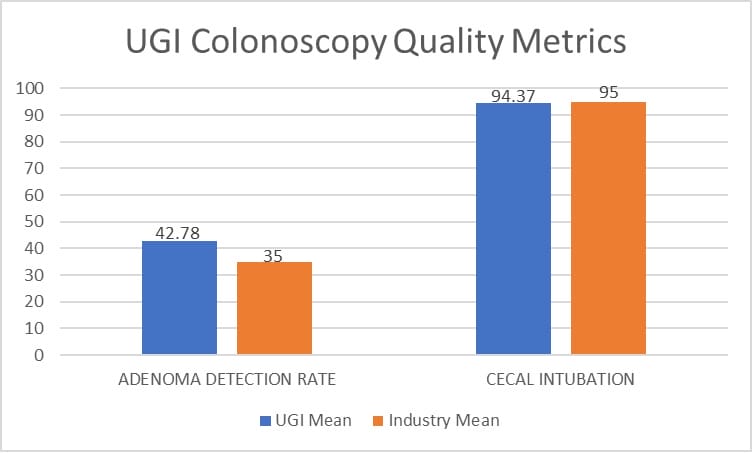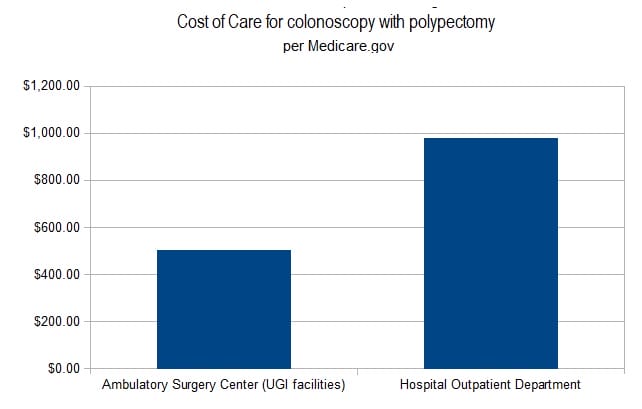Request an Appointment
Quality Care Initiatives
Quality Care Initiatives
At University Gastroenterology (UGI), we are proud of the work that we do every day and believe we provide the highest quality GI care. The mission of University Gastroenterology (UGI) is to provide comprehensive gastrointestinal care in a patient-friendly setting. By using the newest medical technology and implementing the highest clinical standards, the physicians of UGI are dedicated to providing the highest quality care, for a wide array of gastrointestinal and liver diseases, at a reasonable cost.
To make sure we’re meeting our high standards, we keep statistics and data on our performance. This information allows us to see what we are doing well but also shows us areas in which we need to improve. We are happy to share this data, as we believe it is important for our patients and the public to see the quality of the care you receive at UGI.
Several take-home points are listed below; to view the data click on the links below.
- Doctors at UGI remove substantially more pre-cancerous polyps than the national average – this prevents colon cancer.
- Patients rate their experience at UGI and University Endoscopy Group (the endoscopy centers affiliated with UGI) with extremely high satisfaction scores.
- The cost of care at University Endoscopy Group is substantially lower than the cost of care delivered at the local hospital-based endoscopy units
- UGI Physicians and Nurse Practitioners schedule office appointments for new patients faster than the national average.
Point # 1 - Doctors at UGI remove substantially more pre-cancerous polyps than the national average - this prevents colon cancer.
Adenoma Detection Rate (ADR) – The measurement that best reflects how carefully colonoscopy is performed is a doctor’s adenoma detection rate. This rate is defined as the percentage of patients age 50 and older undergoing screening colonoscopy, who have one or more precancerous polyps (adenomas) detected. Colon cancer is prevented by finding and removing these adenomas. The current published national standards are that ADRs should be at least 25-35%. At UGI, our average ADR is approximately 43%.
Cecal Intubation Rate – The percent of the time that a colonoscopy is completed by advancing the scope from the beginning of the colon (rectum) to the end of the colon (cecum). Factors that lower a cecal intubation rate are poor bowel cleansing or preparation, narrowing of the colon or complicated anatomy. Our current cecal intubation rate matches the industry mean.
Doctors at UGI remove on average 18% more polyps than the highest national standards published. We are extremely proud of this and believe it reflects the highest quality care patients receive when they come here for their colonoscopies. The removal of these precancerous polyps prevents colon cancer from occurring.

Point # 2 - Patients rate their experience at UGI and University Endoscopy Group (the endoscopy centers affiliated with UGI) with extremely high satisfaction scores.
We survey our patients on the care they receive both in the office and the endoscopy units. We strive to provide all our patients with an excellent experience, from the time they walk into the office to the time they check out and leave. We find this information enormously helpful to show us what we are doing well and what needs improvement.


Point # 3 - The cost of care at University Endoscopy Group is substantially lower than the cost of care delivered at the local hospital-based endoscopy units
The cost of care at the Ambulatory Surgery Centers (ASCs) affiliated with UGI is substantially lower than the cost of care delivered at the local hospital-based endoscopy units (HOPDs). According to Medicare.gov, for a colonoscopy with polyp removal, the average cost to the patient is $100 at ASCs, and $195 at HOPDs. Medicare pays $403 on average for this procedure at the ASC and $783 for the same procedure at the hospital. There is between a 40 and 50% savings by having the procedure done at the University Endoscopy Group facilities compared to the hospitals! This is a significant savings for both the patient and the insurance provider.

Point # 4 - UGI Physicians and Nurse Practitioners schedule office appointments for new patients faster than the national average.
At UGI, we strive to get patients into the office in a reasonable period of time. Obviously, some patients need to be seen emergently or urgently, and we accommodate these patients the best we can. Other patients have more routine problems that don’t require urgent evaluation but still need attention. According to a recent study by Athenahealth, the national average for wait time to see a GI specialist is 26.1 days. At UGI, we see new patients on average in 17.8 days from the time the referral is sent over to the office. Again, this is significantly better than the national average.

Disease Specific Quality Monitoring Programs
- Colon cancer prevention program
- GERD management program
- Inflammatory Bowel Disease program
- Cirrhosis management program
- Hepatitis C management program
Satisfaction Survey Results
- Patient Satisfaction Survey Results
- Physician Satisfaction Survey Results